-
Call Now
1800-102-2727
Agricultural Implements, Tools, Examples, Practice Problems and FAQs
We all need food to live in this world. To enjoy life and perform the various activities in the body, energy is required. This energy we obtain from food. We know that the basis of food production is agriculture. It is considered as the art and science of cultivating the soil, raising livestock and growing crops. This includes the preparation of animal and plant products for use and also their distribution in markets. Agriculture industry provides most of the food and fabrics required by the world.
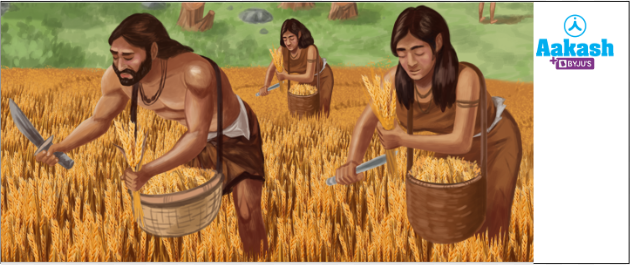
Fig: Agriculture
Due to population explosion the demand for food is increasing. The land area is limited and the conventional production of cereals, pulses, vegetables and fruits may not be able to meet the demand at the rate at which human and animal population is increasing. To resolve this problem to some extent we need mechanisation in the agricultural field.
Agricultural implements play an important role in modern agricultural practices. It is advised to use them in commercial farming practices. These implements can be used for various agricultural activities like field preparation, planting, sowing, threshing, irrigation, harvesting, storage or marketing. Their use can be easily justified with productivity enhancement, less time consumption and labour cost reduction. Hence, there is a need to support their indigenous production and use. Farmers also need to be trained for using these agricultural implements. In this article we are going to discuss agricultural implements in depth.
Table of contents
- Agriculture before industrialisation
- Agriculture after industrialisation
- Agricultural implements
- Common tools of agriculture
- Benefits of agricultural implements
- Practice Problems
- FAQs
Agriculture before industrialisation
Early humans used to lead a nomadic life. They moved from one place to another in search of food and he mainly ate raw vegetables, fruits, and meat. But in the last phase of the Stone Age which is referred to as the Neolithic Age (Neo means ‘new’ and lithic means ‘stone’) humans were skilled enough to make strong sturdy tools from stone and hence they shifted from hunters to cultivators. Then around 10,000 years ago, humans started farming and growing their own food. Thus they shifted to a sedentary lifestyle and they started to occupy land, cultivated their crops and fed on it. This practice of growing the plants on a piece of land and maintaining it, is called agriculture. The plant is called a crop. The maintenance of agriculture crops involves weed removal, irrigation, timely harvesting, storage, marketing the products etc. Early man used to perform all these activities with handmade tools or by physical labour. These tools included sickle, axe, hoe, etc., which they made from stone and wood.

Fig: Agriculture before industrialisation
Agriculture after industrialisation
Several new techniques have been introduced in the field of agriculture during the industrialisation period. This happened due to technological advancements. Now humans are able to make newer and larger machines. These machines reduce manual labours and accomplish agricultural tasks with great ease. In the present world of agriculture, these machines hold great significance. The discovery of modern harvesters and tractors has changed the way of working in the agricultural fields. Farmers can now work more professionally.
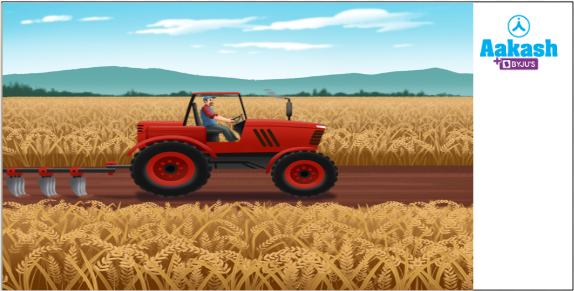
Fig: Agriculture after industrialisation
Agricultural implements
The types of machines used in agricultural practices to reduce human labour and enhance yield of the crops are called agriculture implements. Agricultural implements play a major role in modern agricultural practices. These are widely used in commercial and organic farming. These tools are used for sowing, field preparation, planting, threshing, irrigation and harvesting.
Major agricultural implements include harvesters, drags, disk harrows, seed drills, cultivators, pickages, spades, ploughs, etc. These tools are widely used in countries like India and China where agriculture and farming are primary occupations for most people.
Types of agricultural implements
Various types of agricultural implements are used in farming at different steps of crop production, sowing, irrigation, harvesting, storage, transportation and management. Humans have developed specialised machines for each purpose, Some of these implements are listed below:
Agricultural implements for harvesting
These agricultural implements are used to harvest the matured crops from the fields. The process of gathering parts of a crop when it is fully mature is called harvesting. In earlier days it was done using a sickle which is a sharp and curved device made of metal like iron and wood. In modern agricultural practices harvesters are used for this purpose. Common examples include combine harvesters, diggers, pickers, etc. A combine harvester is a machine that performs reaping, threshing, and cleaning cereal crops in one operation.

Fig: Harvesting using sickle
Agricultural implements for irrigation
These implements help in watering the crops in the fields at the required levels. It includes a basic pump system which is used for drawing water out of the ground and the central pivot irrigation systems. Modern irrigation tools include sprinkler systems, drip irrigation systems etc. These systems help in saving water especially in the areas with water shortage while providing the plants with the required amounts of water. The moisture required for plant germination, growth, and other related processes is supplied by irrigation machinery. Depending on the crops, the soil types, and the seasons, different irrigation methods are used by farmers.

Fig: Sprinkler irrigation system
Planter
These implements are used to plant seeds and saplings over a large land area after the proper preparation of the soil. This is done using precision drills, broadcast seeders, seed drills, air seeders or transplanting equipment in the modern agricultural practices.

Fig: Seed drill
Agricultural implements for soil cultivation
These agricultural implements are used to plough the soil and prepare it properly for cultivation. In the olden days plough was common. Common examples include spikes, disk harrows, drags, etc.

Fig: Preparation of land using plough
Other agricultural implements
These are used in the last stages of agricultural activities such as making hay, shredding, loading, etc. Common examples include shredder and tedder (used for spreading and turning over cut, loose hay in the field).
Common tools of agriculture
Agricultural tools are the instruments used in the fields to aid in the agricultural process. This makes the work easier and less time consuming. Common examples include sickles, hoes, ploughs, drills, etc. Following are the various types of agricultural tools used in farming:
Hoe
A hoe is an ancient agricultural hand tool which is used to shape soil, clear soil, remove weeds, and harvest root crops. It consists of a long rod of wood which can be pulled by the animals or used by human beings. This agricultural implement possesses a strong broad bent plate made of iron called the blade.
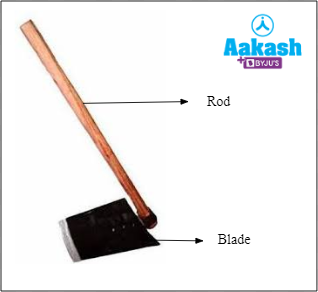
Fig: Hoe
Plough
This agricultural implement is usually made from wood. It is used for turning the soil before sowing seeds and for adding fertilisers. In ancient times ploughs were drawn by horses and oxens. But in modern farms these are drawn by tractors. This agricultural implement consists of a plough shaft (long wooden log). It possesses a strong triangular iron strip known as a ploughshare on one end. The other end of the plough shaft is connected to a beam to place it on the neck of a bull for pulling. In modern agricultural practices the wooden ploughs are replaced by the iron ploughs.
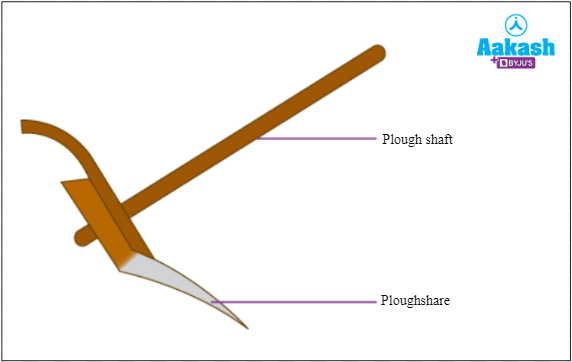
Fig: Plough
Seed drill
This agricultural implement is used for sowing seeds. It is done normally with the help of tractors. This implement sows seeds of crops by positioning them in the soil and burying them to a specific depth and then covers it with the soil. This process allows the plants to get enough nutrients, sunlight, and water from the soil as the proper distance between the saplings are maintained. It saves human labour, and time. It also protects the seeds from animals or birds.

Fig: Seed drill
Cultivator
A cultivator is a piece of agricultural equipment used for secondary tillage. In this a plough is attached to a tractor. This is used to reduce the human labour and it also saves time. This agricultural implement helps to stir the soil around the crops and promote growth and yield. It also destroys weeds.

Fig: Cultivator
Traditional tools
Most of the agricultural communities have the traditional tools like sickles, spades, and axes. The common traditional tool for sowing seeds is a funnel shaped implement. This funnel once filled with seeds passes the seeds through two or three pipes with sharp ends. These ends enter the soil deep and plant the seeds.

Fig: Spade
Benefits of agricultural implements
The agricultural implements are beneficial because of the following reasons:
- It reduces human labour to many folds.
- Labour cost is reduced as the cost of manual labour is more.
- These implements help in efficient crop production and yield.
- Agricultural implements are a one-time investment.
- These implements save money and time.
- Overall income can be improved by the use of agricultural implements.
- It enhances the growth of those agricultural industries, which make these types of machines.
Practice Problems
- The contribution to the world farm products by countries like India and China is ____________.
(A) 25%
(B) 50%
(C) 70%
(D) 10%
Solution: India and China have huge livestock populations and are almost 70 % in the world. But their productivity is very low and they contribute to only 25% of world farm produce. Hence the correct option is ‘A’.
- Identify from the options given below, the percentage of world livestock population present in India and China?
(A) 50%
(B) 25%
(C) 70%
(D) 75%
Solution: India and China have a huge livestock population of about 70 % of the world. But the productivity is only 25 %. Therefore, some standard practices for animal breeding are applied to achieve improvement in quality and productivity. Hence the correct option is ‘C’.
- Central Rice Research Institute (IRRI) is located in ____________.
(A) Japan
(B) Cuttack
(C) Philippines
(D) Mexico
Solution: The International Rice Research Institute (IRRI) is an international agricultural research and training organisation. Its headquarter is in the Philippines, and it has offices in seventeen countries. It aims to improve the health of those who are dependent on rice-based agri-food systems. It aims to ensure that rice farming is done in an environmentally sustainable manner. Hence the correct option is ‘C’.
- The International Centre for Wheat and Maize Improvement is situated at ___________.
(A) Mexico
(B) Philippines
(C) New Delhi
(D) Switzerland
Solution: The International Centre for Wheat and Maize Improvement is located in Mexico. Semi dwarf varieties of wheat were developed here by Norman E. Borlaug, the father of the green revolution. Sonalika and Kalyan Sona developed by him later introduced all over the wheat growing belt of India, as it was high yielding and disease resistant.
FAQs
- What is the major difference between the equipment and tool?
Answer: An equipment refers to a set of tools which are used to achieve a specific objective whereas a tool can be refers to an item which is used to achieve a goal.
- What is considered as the first tool?
Answer: The Early Stone Age tools are considered as the first tools. Around 2.6 million years ago the earliest stone tool making developed. The Early Stone Age began with the basic stone implements made by early human beings. Examples include stone cores, hammerstones, and sharp stone flakes.
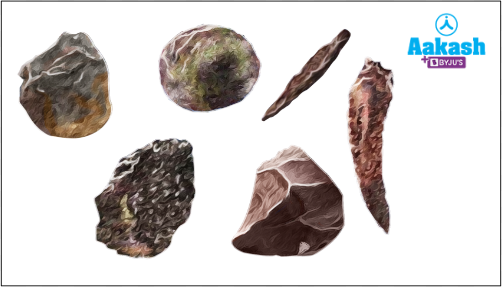
Fig: Early Stone Age tools
- Who has invented the tool?
Answer: It is believed that the hominid species Australopithecus afarensis ate meat by carving animal carcasses with stone implements. Hence the earliest known use of stone tools might have happened around 3.4 million years ago. Actual tools date back to around 2.6 million years ago in Ethiopia.

Fig: Australopithecus
- Name a few modern agricultural implements?
Answer: Modern agricultural implements include combine harvester, rotary tiller, Plough, trailers, tractors, levellers, water bowsers, power harrows, ripper machines, disc harrows etc.



